By Carolyn Edlund
Calligrapher Ken Brown is a native Oklahoman with a delightful drawl and easy manner. He is a humble man, yet the name “Ken Brown” is a powerhouse in the art market.
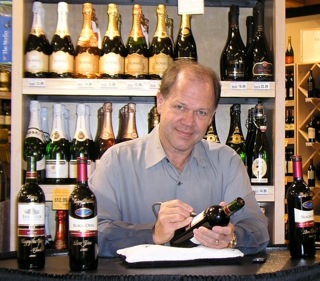
Ken Brown calligraphy sets and instruction books have sold for many years, and his series of televised calligraphy instruction classes have been shown around the world. Ken and his wife Gail (a watercolor artist) have partnered on creating prints which have sold many millions of copies.
AS: Ken, you started out with a passion for calligraphy and a lot of determination. Could you give a short history of how you began your business?
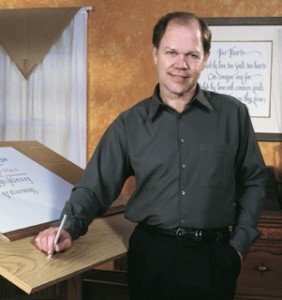 KB: In the third grade, I learned cursive writing.I felt it was a curse. Hated every minute at first. From there on, my appreciation for pretty penmanship grew. In college, a lettering assignment in architectural design got a grade of B minus. It became a defining moment in my life. It was SO defining, I flunked out of college; all my studies suffered while I practiced calligraphy. After 11 years in various jobs and moonlighting calligraphy, I went full time out of a spare bedroom. From that gutsy move, I hustled and found that I could earn more by lettering a poem and selling copies.
KB: In the third grade, I learned cursive writing.I felt it was a curse. Hated every minute at first. From there on, my appreciation for pretty penmanship grew. In college, a lettering assignment in architectural design got a grade of B minus. It became a defining moment in my life. It was SO defining, I flunked out of college; all my studies suffered while I practiced calligraphy. After 11 years in various jobs and moonlighting calligraphy, I went full time out of a spare bedroom. From that gutsy move, I hustled and found that I could earn more by lettering a poem and selling copies.
AS: What is a “distribution source” and how has it catapulted your business into a highly successful venture?
KB: It began with a small crafts shop near our home. The owner bought 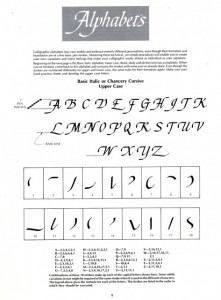 copies of my lettered poems, quotes, etc., that I had produced at a local commercial printer. I then purchased a small ad in a national trade magazine going to similar stores nationwide. That exposure brought responses and orders from distributors of crafts materials. They purchased larger quantities and resold to retailers. Within a year we were selling many, many thousands of prints monthly and shipping to stores all over the U.S.
copies of my lettered poems, quotes, etc., that I had produced at a local commercial printer. I then purchased a small ad in a national trade magazine going to similar stores nationwide. That exposure brought responses and orders from distributors of crafts materials. They purchased larger quantities and resold to retailers. Within a year we were selling many, many thousands of prints monthly and shipping to stores all over the U.S.
Six years later, after exhibiting our prints in art shows across the country, the nation’s major manufacturer of calligraphy pens, inks, and papers offered a lucrative proposal for me to write an instruction book for them. I wrote the book for the company, Hunt Manufacturing in Philadelphia, PA, became their spokesperson in 1977, and then had instant distribution of my name and products internationally. For the next 18 years I sold books to Hunt and traveled widely for the company. In 1985 they sent my wife and me to Norway on a two week teaching junket. The Norway distributor for Hunt products set up 12 teaching and demonstration sessions at schools and professional graphics firms in five Norwegian cities.
AS: You keep moving with your product lines and your methods as you develop your business. Could you talk about how this has enhanced your career, and why it’s important?
KB: More business facets equal more customers. From the beginning, I’ve tried to take calligraphy in many directions and uses. In 1974 I wrote a poem, printed copies, and sold them with an item, as a gift for baby showers. We sold them briskly through specialty magazine ads and that, later, brought new customers to awareness of my calligraphy prints and supplies. At the same time, we were creating decals for china painters, self-adhesive decals with sayings for decoupage and rub-on transfers of entire poems and quotes for framing. Several years later, through Plaid Enterprises in Atlanta, GA, we developed a line of rubber stamps, a line of Ken Brown calligraphy markers, a layout template, and numerous other calligraphy-related products.
AS: What advice on branding would you give to others starting in business?
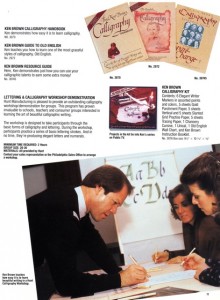 KB: Just after the pen manufacturer published my first book, I developed a beginner’s kit with an instruction booklet. That spawned opportunities to broaden the product line. It was necessary to get my name connected with as many products and promotions as possible. I’ve never been shy about putting a ‘face’ on my work. It makes the customer and prospect feel they are dealing with a real human being. There was never a real Betty Crocker, yet the name and an image has appeared on zillions of products and cookbooks for decades, and still does. Often I’ll visit a website of an artist or specialist and never see a photo of the person. I’m always amazed. You’ll find that branding yourself in your own way with your own products and promotional materials will pay great dividends.
KB: Just after the pen manufacturer published my first book, I developed a beginner’s kit with an instruction booklet. That spawned opportunities to broaden the product line. It was necessary to get my name connected with as many products and promotions as possible. I’ve never been shy about putting a ‘face’ on my work. It makes the customer and prospect feel they are dealing with a real human being. There was never a real Betty Crocker, yet the name and an image has appeared on zillions of products and cookbooks for decades, and still does. Often I’ll visit a website of an artist or specialist and never see a photo of the person. I’m always amazed. You’ll find that branding yourself in your own way with your own products and promotional materials will pay great dividends.
I’m the first to admit, I’m not the best calligrapher….by a long shot. But I’ll also admit, my name is probably the best known in the field of calligraphy because I’ve strived to achieve recognition for good work and to be known for it. I’m often still recognized by strangers who purchased my books long ago . . . even though my hair is a bit thinner now. Certainly, I was fortunate to have caught the attention of the Hunt company when I did. I worked hard for years to be recognized in all my efforts and that paid off. Without that branding and my photo on my products from the very beginning, I’d be among the world’s ‘good calligraphers’ struggling to get myself known and wondering why it doesn’t happen.
AS: Please tell us about your newest technique of engraving, who you are working with and how you are marketing.
KB: In 1992 I was teaching calligraphy at a California art symposium. I met a dentist who told me I should get a dental drill and learn to do calligraphy with it. Sounded strange but I got one and taught myself. It became the biggest change yet in using my calligraphy. Doing calligraphy with a dental drill has broadened my “palette” enormously. No longer tethered to paper and parchment, now I can apply my calligraphy to hundred of items and surfaces. I’m marketing my skills at www.kenbrown.com and through exposure like Artsy Shark.
AS: You have a teaching program for people who want to learn calligraphic engraving. How does this work?
KB: Prospective students, who have visited our site, call us for additional 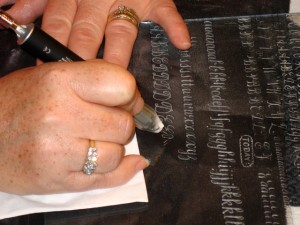 info. When they enroll, they receive a packet of laminated sheets with the letters to practice and learn. With soft lead pencil and tracing paper, they learn the strokes before coming to class to learn them with the drill. We do several projects on various surfaces. They learn layout and all is totally hands-on. I teach with a digital camera and projector so students see everything on a large screen in the workshop room.
info. When they enroll, they receive a packet of laminated sheets with the letters to practice and learn. With soft lead pencil and tracing paper, they learn the strokes before coming to class to learn them with the drill. We do several projects on various surfaces. They learn layout and all is totally hands-on. I teach with a digital camera and projector so students see everything on a large screen in the workshop room.
AS: How do people proceed if they want to learn your unique skill?
KB: They call (214) 250-6958 and enroll with a credit card. Seminars are usually held in McKinney, Texas, near Dallas but if there are at least 10 students in any other U.S. location, we’ll take the Seminar there. Published prices will change depending upon location and number of students.
AS: Why would anyone want to learn hand-engraving? Aren’t there engraving services in many stores?
KB: About 80% of my day-to-day business comes from engraving stores who cannot engrave what people bring them; they give the customer my card. There are so many items that traditional engravers, even those with laser systems, cannot fit into their machines. The items must be hand-engraved. Also, at the many in-store events where I engrave wine bottles, fragrance bottles, knives, guns, crystal, and other items, ONLY a hand-engraver could accomplish the task of personalizing several hundred items in an 8 hour event. And, finally, day rates range from $600.00 to $1500.00 per 8 hour event for those of us who hand-engrave in stores. That’s probably the biggest reason, for the few of us who do, we wanted to learn hand-engraving.



Speak Your Mind